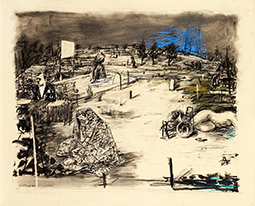Archived
William Kentridge - 'Shrouded Figure in a Landscape [Taking in the Landscape]'
16 May 2015
Important South African and International Art, Johannesburg, Lot 258

William Kentridge – Shrouded Figure in a Landscape [Taking in the Landscape]
Quotation is deeply woven into the fabric of William Kentridge’s output as an artist, his collected work representing a sustained dialogue with what he in 2012 described as the ‘universal archive’.1 Anonymous news photographs, an image by Max Beckman, an idea from Theodor Adorno, postcards, Vladimir Tatlin’s unrealised monument to the Third International (1920), a family snapshot: these and countless other visual sources have been synthesised into his highly original practice. This particular work exemplifies his manner of recomposing art history. The work variously and suggestively reinterprets Goya and Otto Dix’s landscapes alongside Eugène Delacroix’s description of conflict and sexuality in his painting Liberty Guiding the People (1830), without lapsing into pastiche.
A prolific artist, even before his arrival on the world stage in the late 1990s, this unique drawing highlights another aspect of Kentridge’s process-driven work: he is always in conversation with his own image archive. The man in the dinner suit and bowtie, at left, is a stock figure from the artist’s earlier drawings series, notably inDreams of Europe (1984–85) andThe Conservationists’ Ball (1985), that essayed haute bourgeois manners. It is also consistent with the ruined Highveld landscape scenes he began rendering in charcoal and pastel on paper in the late 1980s, for example inAn Embarkation (1988) and Urbanise (1989). The blank billboard, which first appeared in his 16mm film Johannesburg, Second Greatest City After Paris (1989), is a key fixture in his early ‘drawings for projection’ series of films. While cryptic, the draped figure in the foreground is in fact a variation of a dancing woman clothed in newspapers who appears in another large-scale drawing from this period, Anti-Waste (1990).2
Produced while working on his short second film, Monument (1990), the drawing does not appear in the film but explores similar themes of labour (the miner emerging from the swimming pool) and mass communication (the speakers at the naked figure’s feet).3 Kentridge also produced a smaller charcoal and pastel variant of this work, Taking in the Landscape (1990), in which the order of the two female figures (early studies of industrialist Soho Eckstein’s daughter, Liberty) are switched. His Little Morals, a series of etching from 1991, also quotes this particular drawing, albeit with a draped monument interposed into the scene.
1 William Kentridge. (2014) Six Drawing Lessons, Cambridge: Harvard University Press. Page 24.
2 William Kentridge. (1999) William Kentridge, London: Phaidon. Page 116.
3 Confirmed by the artist’s studio, 20 April 2015.
2015 Press Releases
November
- 3 Nov 2015 A Woman of Substance
- 9 Nov 2015 Gold miner shines in bronze
- 9 Nov 2015 Top Ten, 9 November 2015
- 23 Nov 2015 Stephan Welz speaks on the Jewish contribution to cultural life in South Africa
October
- 5 Oct 2015 Property from the Rodwell House Collection
- 5 Oct 2015 Randlord's furniture appears on market 65 years later
- 13 Oct 2015 R2 600 000 for chest of drawers
- 13 Oct 2015 Top Ten, 12 October 2015
- 15 Oct 2015 Van Wouw Dagga Smoker won with ten cent raffle ticket among highlights at Strauss & Co's Johannesburg Auction on 9 November 2015
- 16 Oct 2015 Strauss Summer Auction headlined by rare and exemplary works by Preller, Stern, Kentridge, Pierneef and Van Wouw
September
- 3 Sep 2015 Strauss & Co launches new improved website
- 4 Sep 2015 Ten Cent raffle ticket wins half a million Rand artwork
- 10 Sep 2015 Rare Portrait of Childhood by Peter Clarke at Strauss Auction
- 15 Sep 2015 Strauss Spring Auction Set to Surprise and Delight
- 25 Sep 2015 Erik Laubscher: Toast of the Town
June
- 2 Jun 2015 A record price for & quot kitchen boy" painting
- 2 Jun 2015 Dolly commands millions
- 2 Jun 2015 Sculpture price soars to dizzy heights
May
- 16 May 2015 Alexander Calder - 'Spiral',
- 16 May 2015 Half a Century of Robert Hodgins at Strauss & Co
- 16 May 2015 Jane Alexander - 'Serviceman'
- 16 May 2015 Kees van Dongen - 'Dolly au collier d'argent'
- 16 May 2015 Walter Battiss - 'Untitled'
- 16 May 2015 William Kentridge - 'Shrouded Figure in a Landscape [Taking in the Landscape]'
- 20 May 2015 Modern and contemporary art steals the show at Strauss & Co's June sale
- 28 May 2015 Hello Dolly! Portrait of artist's daughter expected to fetch R4 million
- 30 May 2015 Athi-Patra Ruga - Dancing Figure
April
March
- 6 Mar 2015 Art with Global Appeal at Strauss Auction
- 6 Mar 2015 Kimberley Diamond Rush Brooch to benefit Save the Children Fund
- 6 Mar 2015 Pierneef Painting that Launched Cultural Movement Headlines Strauss Auction
- 6 Mar 2015 The Arch Flies Again
- 7 Mar 2015 Preller's Mapogga Wedding at Strauss & Co
- 9 Mar 2015 Harvey Collection Celebrates South African History
- 9 Mar 2015 Mapogga Blissful Nuptials at Strauss & Co Auction
- 9 Mar 2015 Top Notch Tretchi Shines at Strauss & Co Auction
- 10 Mar 2015 Artist and Son Reunited
- 10 Mar 2015 Hodgins' Favourite Scheduled for Strauss & Co Auction
- 11 Mar 2015 JH Pierneef - Master of the Medium
- 18 Mar 2015 Strauss & Co Top 10 Results for 16 March 2015 Auction
- 20 Mar 2015 Strauss & Co reaffirms its global supremacy in the South African art market
- 20 Mar 2015 Tutu sculpture sells for over R850 000 at Strauss & Co auction
February
- 3 Feb 2015 Chairman's Report, 2014
January
